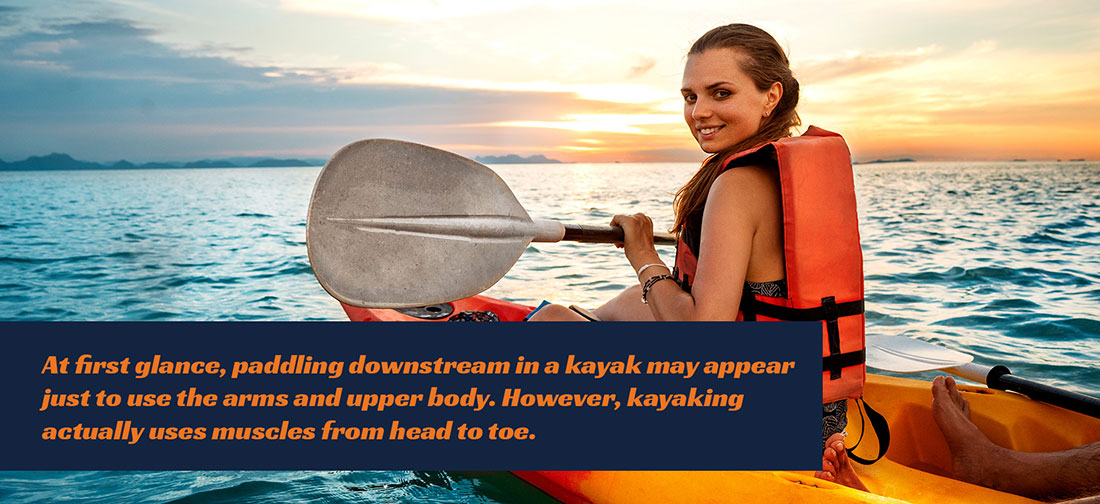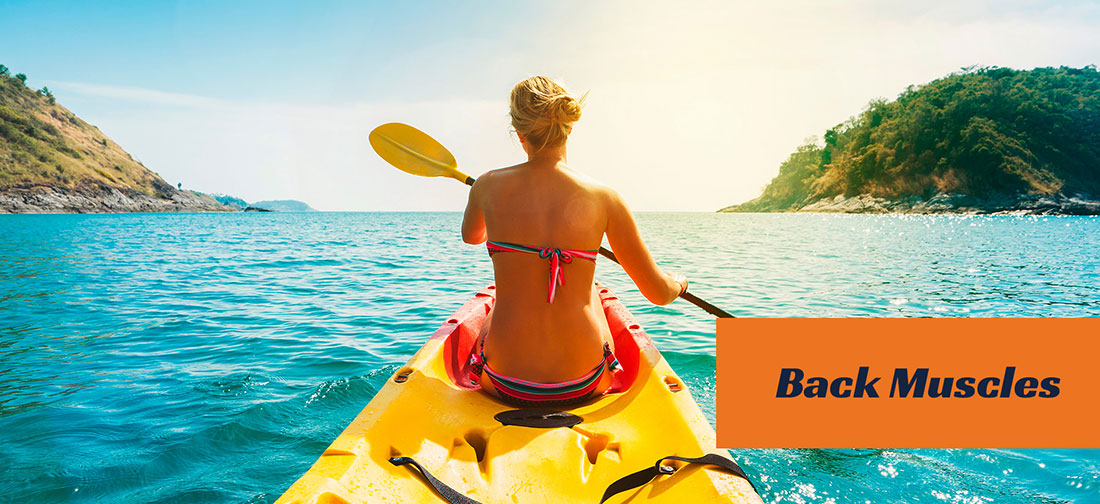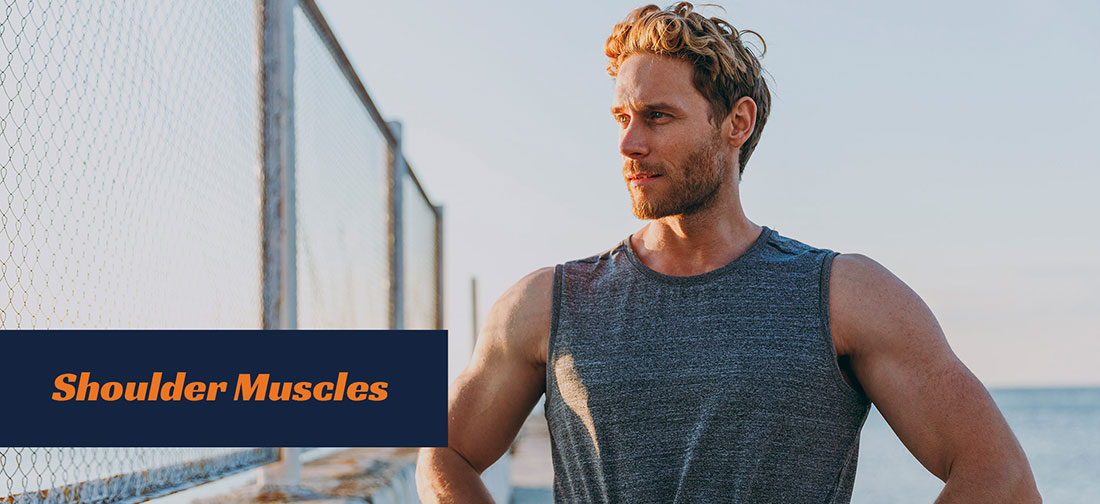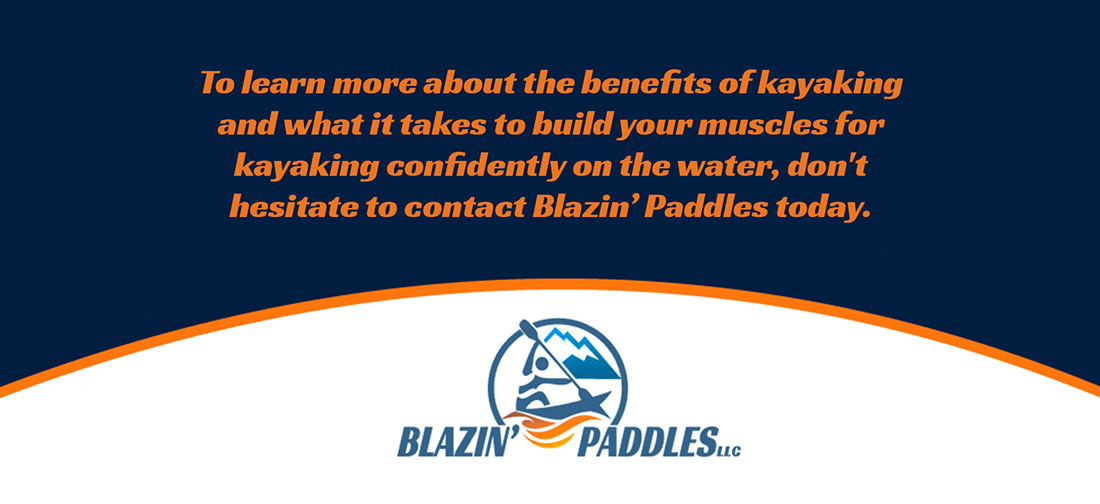What Muscles Does Kayaking Benefit?
At first glance, paddling downstream in a kayak may appear just to use the arms and upper body. However, kayaking actually uses muscles from head to toe. In addition to providing a full body workout, Las Vegas kayaking is a great way to see some of the most majestic landscapes and beautiful places in the Southwest.
What Makes Kayaking a Good Workout?
Colorado River kayaking is a sport that uses muscle groups throughout the body. The arms, back, torso, neck, and legs all get a good workout from spending a day out on the water on a Hoover Dam kayak tour. Whether you’re looking to get in shape, stay fit, or build muscle mass, kayaking is a good sport for your fitness goals.

Back Muscles
There are many different muscles in your back. Those muscles can become toned and strengthened through training, making even a long Vegas kayak tour seem much easier. The back muscles consist of the latissimus dorsi, rhomboids, trapezius, and serratus anterior. Although many beginner kayakers use their arm muscles more than any other muscle when paddling, the back muscles are some of the key muscles you will need to tone and use for Colorado River kayaking. Of all the muscles in the back, the latissimus dorsi (lats) are the primary muscles used for kayaking. These muscles are large and wide, and they help distribute power from the back to the lower body. The lats help move energy from the back into the arms. Every stroke you take with the paddle helps strengthen the lats and makes them even more efficient. As you build up your lats, you can adjust your paddle strokes and rhythm to strengthen the muscles. To build strength in the lats, try changing your rowing speed. You can paddle slower for shorter intervals during a Hoover Dam kayak tour, for instance, or use deeper and slower strokes for a more extended time.
The rhomboids consist of both major and minor muscles. They are located in the middle of the upper back. The rhomboids are primarily used for rotating the shoulder blades. The rhomboids are another important muscle group used for paddling when you kayak Hoover Dam, and they also help you maintain good posture. When you reach the end of a kayak stroke, the rhomboids contract as your shoulder blades moves toward the spine. Moving the rhomboids makes them better for paddling and helps improve your posture both in the boat and when you are on land.
Trapezius muscles, or your “traps,” are another large group of muscles in the back. The traps are located below the rhomboids and the lats. The traps are in the middle of the back and divided into upper, middle, and lower muscle groups. The upper traps help you move your shoulders, but the middle and lower traps are used more in kayaking. Since the traps are essential muscles for kayaking, it’s important to make sure you warm the muscles up before getting in the boat. When you finish kayaking for the day, you should perform some basic stretches as a trap cool-down.
The serratus anterior runs the length of the side of your chest, and this muscle begins at the first rib and extends to the eighth rib—the serratus anterior stops at the scapula. The serratus anterior helps move the scapula forward, stabilizing the shoulder blades while you kayak Hoover Dam.

Shoulder Muscles
The shoulders also consist of several muscles that help with kayaking, including:
- Anterior deltoid
- Rear deltoid
- Lateral (Medial) deltoid
Collectively, the muscles in your shoulder work together to move power from your back muscles through the arms so that you can complete a paddle stroke. The deltoid muscles are next to each other, forming a triangle shape in the shoulder. The rear deltoid is located closest to the back, the medial deltoid is in the center of the shoulder, and the anterior deltoid is closest to the chest. These muscles will become stronger as you use them more and more during Las Vegas kayaking. The rowing motion of your kayak stroke means you need to move the paddle up and forward. In the process, weight is redistributed from your back to your shoulders.

Chest Muscles
The chest muscles are equally crucial for paddling in Las Vegas kayak tours. The primary chest muscles are the pectoralis minor and the pectoralis major. Both muscles, which are commonly called the “pecs,” work to move your arm with every stroke. At the same time, they help to keep your shoulder steady and stable. Simultaneously, they help to rotate your torso so that you can effectively and efficiently move the kayak forward. The pecks give you a solid foundation of muscular strength and stability so that you can have a comprehensive workout.
Core Muscles
The core muscles consist of the abdominals and the obliques—a variety of rotational movements that are necessary for paddling help to work the oblique and the abs. Contracting the abs is the best way to work and use your core muscles. When you first start Las Vegas kayak tours, your muscles may not be used to complete the workout, leaving them feeling sore and tired for a few days afterward. Once you start to build up muscle strength, however, you will find that your core muscles make kayaking easier and easier with each trip out on the river.
Some people wonder if they can develop the benefits of kayaking like a “six-pack.” The answer, ultimately, is that you can undoubtedly create the foundation for a six-pack through kayaking. The movement of the paddling stroke means that the obliques will become more toned than the abdominals. Continually moving your core muscles is what will ultimately help you develop a “six-pack.”
Arm Muscles
The arm muscles are further categorized into two separate groups: the upper arm muscles and the lower arm muscles. The upper arm muscles consist of the biceps and triceps, and the biceps and triceps work together to provide the torque power necessary to help you complete a kayak stroke. Additionally, kayaks have a double-blade design, which also helps develop, define, and tone your arm muscles.
Along with the two upper arm muscles, your arms also have the forearms and the gripping muscles. The forearms and hand muscles are used every time you paddle. Naturally, the more frequently you paddle, the stronger these muscles will become. The end result is toned lower arms and an excellent strength-building workout for your entire arm. The hands and forearms move throughout the workout by stretching, contracting, and rotating. Initially, you might not have much stamina in these muscles when rowing, but your strength and paddling efficiency will increase over time. Before you know it, you’ll find that these muscles have tremendous endurance.
Leg and Hip Muscles
Your lower body muscles are also used quite a bit, whether you are just learning to kayak or going on a kayak tour. Many people don’t think that kayaking uses leg and lower body muscles since it initially appears to be an upper-body activity. However, kayaking is also a great lower-body activity. When you paddle the boat, you lean with your legs against the sides of the kayak. Your legs and hips help you balance with every stroke. As you kayak more often and go longer distances, your leg and hip muscles will become stronger.
To learn more about the benefits of kayaking and what it takes to build your muscles for kayaking confidently on the water, don’t hesitate to contact Blazin’ Paddles today.

